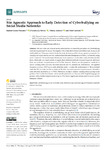Site agnostic approach to early detection of cyberbullying on social media networks

Use este enlace para citar
http://hdl.handle.net/2183/33949
A non ser que se indique outra cousa, a licenza do ítem descríbese como Attribution 4.0 International
Coleccións
- Investigación (FIC) [1679]
Metadatos
Mostrar o rexistro completo do ítemTítulo
Site agnostic approach to early detection of cyberbullying on social media networksData
2023-05Cita bibliográfica
M. López-Vizcaíno, F.J. Nóvoa, T. Artieres, and F. Cacheda, "Site Agnostic Approach to Early Detection of Cyberbullying on Social Media Networks", Sensors 2023, 23, 4788. https://doi.org/10.3390/s23104788
Resumo
[Abstract]: The rise in the use of social media networks has increased the prevalence of cyberbullying, and time is paramount to reduce the negative effects that derive from those behaviours on any social media platform. This paper aims to study the early detection problem from a general perspective by carrying out experiments over two independent datasets (Instagram and Vine), exclusively using users’ comments. We used textual information from comments over baseline early detection models (fixed, threshold, and dual models) to apply three different methods of improving early detection. First, we evaluated the performance of Doc2Vec features. Finally, we also presented multiple instance learning (MIL) on early detection models and we assessed its performance. We applied (Formula presented.) ((Formula presented.)) as an early detection metric to asses the performance of the presented methods. We conclude that the inclusion of Doc2Vec features improves the performance of baseline early detection models by up to 79.6%. Moreover, multiple instance learning shows an important positive effect for the Vine dataset, where smaller post sizes and less use of the English language are present, with a further improvement of up to 13%, but no significant enhancement is shown for the Instagram dataset.
Palabras chave
Cyberbullying
Early detection
Machine learning
Multiple-instance learning
Social networks
Text features
Early detection
Machine learning
Multiple-instance learning
Social networks
Text features
Versión do editor
Dereitos
Attribution 4.0 International






